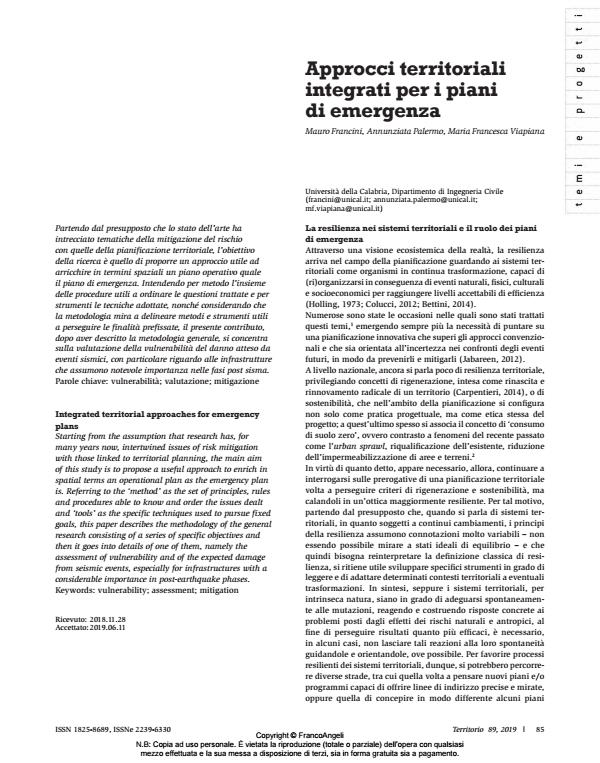Approcci territoriali integrati per i piani di emergenza
Titolo Rivista TERRITORIO
Autori/Curatori Mauro Francini, Annunziata Palermo, Maria Francesca Viapiana
Anno di pubblicazione 2019 Fascicolo 2019/89
Lingua Italiano Numero pagine 6 P. 85-90 Dimensione file 130 KB
DOI 10.3280/TR2019-089011
Il DOI è il codice a barre della proprietà intellettuale: per saperne di più
clicca qui
Qui sotto puoi vedere in anteprima la prima pagina di questo articolo.
Se questo articolo ti interessa, lo puoi acquistare (e scaricare in formato pdf) seguendo le facili indicazioni per acquistare il download credit. Acquista Download Credits per scaricare questo Articolo in formato PDF

FrancoAngeli è membro della Publishers International Linking Association, Inc (PILA)associazione indipendente e non profit per facilitare (attraverso i servizi tecnologici implementati da CrossRef.org) l’accesso degli studiosi ai contenuti digitali nelle pubblicazioni professionali e scientifiche
Partendo dal presupposto che lo stato dell’arte ha intrecciato tematiche della mitigazione del rischio con quelle della pianificazione territoriale, l’obiettivo della ricerca è quello di proporre un approccio utile ad arricchire in termini spaziali un piano operativo quale il piano di emergenza. Intendendo per metodo l’insieme delle procedure utili a ordinare le questioni trattate e per strumenti le tecniche adottate, nonché considerando che la metodologia mira a delineare metodi e strumenti utili a perseguire le finalità prefissate, il presente contributo, dopo aver descritto la metodologia generale, si concentra sulla valutazione della vulnerabilità del danno atteso da eventi sismici, con particolare riguardo alle infrastrutture che assumono notevole importanza nelle fasi post sisma.
Parole chiave:Vulnerabilità; valutazione; mitigazione
- Computational Science and Its Applications – ICCSA 2021 Priscilla Sofia Dastoli, Piergiuseppe Pontrandolfi, pp.665 (ISBN:978-3-030-86969-4)
- Computational Science and Its Applications – ICCSA 2022 Workshops Priscilla Sofia Dastoli, Piergiuseppe Pontrandolfi, Francesco Scorza, Simone Corrado, Antonello Azzato, pp.253 (ISBN:978-3-031-10544-9)
Mauro Francini, Annunziata Palermo, Maria Francesca Viapiana, Approcci territoriali integrati per i piani di emergenza in "TERRITORIO" 89/2019, pp 85-90, DOI: 10.3280/TR2019-089011